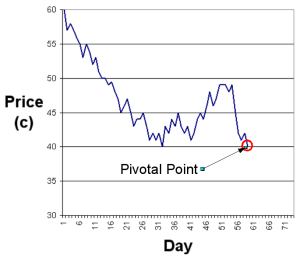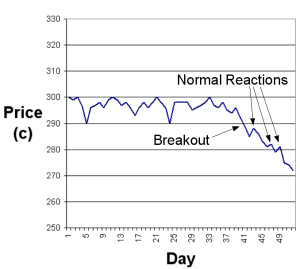Jesse Livermore
What's so interesting
About Jesse Livermore?
Time Magazine described Jesse Livermore as the most fabulous living U.S. stock trader.
His progress from office boy to Wall Street legend - his trading lessons - his triumphs and disasters - is probably the most fascinating of any of Wall Street's stories.
Even today, many stock and commodity traders owe Jesse Livermore a deep debt of gratitude for sharing his trading experiences in Reminiscences of a Stock Operator.
The techniques Jesse Livermore made public between the 1920s and 1940s have survived him. This follows from the durability of his basic trading rules - rules that made him millions of dollars, provided he remained faithful to them.
Livermore also lost his entire fortune on more than one occasion, when he ignored his trading rules.
Reminiscences of a Stock Operator
In a series of interviews with "Lawrence Livingstone" (a pseudonym for Jesse Livermore) the financial journalist Edwin Lefèvre got to the heart of the methods and psychology of a master stock market trader. Lefèvre published his interviews in Reminiscences of a Stock Operator. Interviews with Livermore were highly prized because, as far as his market activities were concerned, Livermore was a secretive loner.
The purpose of this site is to discuss and analyze Livermore's experiences and methods in order to provide useful information for today's novice traders.
To give you a brief taste of where we will go, here are some comments from Jesse Livermore himself:
"The game of speculation is the most uniformly fascinating game in the world. But it is not a game for the stupid, the mentally lazy, the man of inferior emotional balance, or for the get-rich-quick adventurer. They will die poor."
"...the fruits of your success will be in direct ratio to the honesty and sincerity of your own effort in keeping your own records, doing your own thinking, and reaching your own conclusions."
"There is nothing new in Wall Street. There can't be because speculation is as old as the hills. Whatever happens in the stock market today has happened before and will happen again."
"There are times when money can be made investing and speculating in stocks, but money cannot consistently be made trading every day or every week during the year. Only the foolhardy will try it. It just is not in the cards and cannot be done."
"The point is not so much to buy as cheap as possible or go short at top price, but to buy or sell at the right time."
"I am tired of hearing the public and papers blame Wall Street for parting fools from their money... It's the successful business man who is the biggest sucker of the lot. He has made a fortune in his own line. How? By being on the job for years; by learning all there was to know about it; by taking reasonable chances; by utilizing his knowledge and experience to anticipate probabilities. He wants to increase that fortune at a faster rate and with less effort."
"It took me five years to learn to play the game intelligently enough to make big money when I was right."
"Speculation is far too exciting. Most people who speculate hound the brokerage offices... the ticker is always on their minds. They are so engrossed with the minor ups and downs, they miss the big movements."
Patterns in Stock Prices
Jesse Livermore's Trading Methods
At the heart of Jesse Livermore's spectacular trading success was the skill he acquired as an eager 14 year old transferring stock prices from ticker tape to quote board - the skill of deducing the likely future movements of stock prices.
Livermore said, "To invest or speculate successfully, one must form an opinion as to what the next move of importance will be in a given stock. Speculation is nothing more than anticipating coming movements. In order to anticipate correctly, one must have a definite basis for that anticipation... "
Livermore believed that, if you thought a stock would move in a certain way, you should enter a trade as early as possible after the market had confirmed your judgement.

What Patterns Did Livermore Look For?
Jesse Livermore liked to trade stocks whose price was moving in an obvious trend. He was not interested in trading stocks whose price was meandering - moving up and down with no strong trend - such as the one shown on the left.
The patterns he sought to identify were patterns in the prices. Modern traders - and indeed many traders in Livermore's time too - plotted the prices and volumes against time on a chart. Jesse Livermore, however, did not use charts. He preferred to look at the numbers themselves.

The Pivotal Point
Jesse Livermore wrote:
"Whenever I have had the patience to wait for the market to arrive at what I call a Pivotal Point before I started to trade; I have always made money in my operations."
Consider the chart on the left. The price had been trending downwards before rallying from a low of 40c. The rally could not be maintained, however, and the stock has retreated to 40c again. 40c has become what Jesse Livermore called a pivotal point. Any significant move either upwards or downwards from the pivotal point would be traded by Livermore.
If the stock were to break below, say, 37c, Livermore would sell short. If it were to break above, say, 43c, Livermore would buy. He would observe the price action carefully after the buy because 49c - the high of the earlier rally - is another pivotal point. If the price failed to rally above 49c - again by 3c, say - Livermore would exit from the trade.
Livermore said:
"I never benefited much from a move if I did not get in at somewhere near the beginning of the move. And the reason is that I missed the backlog of profit which is very necessary to provide the courage and patience to sit thourgh a move until the end comes - and to stay through any minor reactions or rallies which were bound to occur from time to time before the movement had completed its course."

The Normal Reaction
Once a stock had broken out of a trading range - such as the stock on the left, which has broken downwards - Livermore would begin trading. In this case the breakout is downwards and so Livermore would sell the stock short.
He would look for signs that the new trend was behaving normally and that it would be safe to stick with the trade.
Jesse Livermore would look for the following signs:
- At the beginning of the move there should be an unusually large volume of shares traded.
- Prices should move generally in one direction (upwards or downwards) for a few days.
- A normal reaction should be observed - volume will decrease compared with the volumes observed during the initial trend, and the price may move against the trend somewhat.
- Within a day or two of the normal reaction, volume should increase again and the price trend should be resumed.
Provided this pattern is repeated, it is safe to stick with a trade. If there should be a deviation from the pattern, it is a warning sign. If the pattern fails and the price moves against the trend by more than a little, it is a sign to exit your trade and preserve your profit.
Trading Rules
Jesse Livermore's Stock Trading Rules
All successful stock and commodity traders have rules for buying and selling. Many traders today still use the trading rules Jesse Livermore first devised almost a century ago.
Jesse Livermore constructed his rules over several years while he learned by trial and error what worked on the markets. He was guided by one of his favorite principles:
"There is nothing new in Wall Street. There can't be because speculation is as old as the hills. Whatever happens in the stock market today has happened before and will happen again."
Trading Rules
- Buy rising stocks and sell falling stocks.
- Do not trade every day of every year. Trade only when the market is clearly bullish or bearish. Trade in the direction of the general market. If it's rising you should be long, if it's falling you should be short.
- Co-ordinate your trading activity with pivot points.
- Only enter a trade after the action of the market confirms your opinion and then enter promptly.
- Continue with trades that show you a profit, end trades that show a loss.
- End trades when it is clear that the trend you are profiting from is over.
- In any sector, trade the leading stock - the one showing the strongest trend.
- Never average losses by, for example, buying more of a stock that has fallen.
- Never meet a margin call - get out of the trade.
- Go long when stocks reach a new high. Sell short when they reach a new low.
Other Useful Trading Guidance
- Don't become an involuntary investor by holding onto stocks whose price has fallen.
- A stock is never too high to buy and never too low to short.
- Markets are never wrong - opinions often are.
- The highest profits are made in trades that show a profit right from the start.
- No trading rules will deliver a profit 100 percent of the time.
